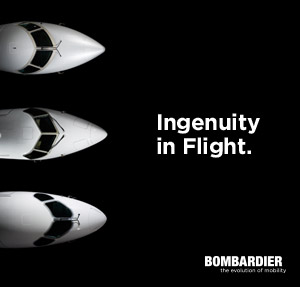Jetcraft Avionics Announces First Installation of Enhanced Flight Vision Systems (EFVS) On Pre-Owned Aircraft
Written by thomas · Filed Under Aeronautics NewsOctober 9, 2008
ORLANDO, FL, October 5, 2008 –Jetcraft Avionics announced today at the National Business Aviation Association
(NBAA) annual meeting its first installation of the Elbit Systems of America Kollsman Enhanced Vision System II (EVS
II) to improve situational awareness and make flights safer. Jetcraft is the only non-OEM distributor of EFVS for preowned
and aftermarket business aircraft. Elbit Systems of America manufactures the Kollsman EFVS.
The installation began mid-August, and FAA certification is anticipated by year-end. The launch aircraft is a
Bombardier Challenger 604. The CL 604 intercontinental business jet was introduced in 1996, and 365 were produced
by October 2006. Jetcraft Avionics also plans to install a next generation HUD, the Kollsman Advanced Technology-
Heads Up Display (AT-HUD), when available in 2009. As the primary distributor of the Kollsman EFVS to various aircraft
already in the marketplace, Jetcraft Avionics is able to customize the installation to the unique needs of each aircraft
type and its existing avionics. Until now, these safety advancements have only been designed for and offered on new
aircraft by their respective OEMs.
Jetcraft Avionics Vice President Ken Elliott said, “For the first time, an equipment OEM (Elbit Systems of America
Kollsman) is able to supply both an EVS and a HUD integrated and designed to meet current and future FAA and
European Union Operations (EU-OPS) landing credit. These unique qualifications are streamlining the design and
Supplemental Type Certificate (STC) process for us. We are very pleased with the progress of the launch STC and the
understanding of our valued customer to facilitate a complex program.”
Proven Technology
Elbit Systems of America Kollsman is a world leader of Enhanced Flight Vision Systems, certifying the first ever vision
based cockpit system, the Kollsman EVS I in 2001. EVS II is lighter and up to three times more sensitive than EVS I and
is currently being incorporated in both commercial air transport and corporate aircraft. This proven technology is
already being used by industry leaders Gulfstream and FedEx in close to 500 aircraft so far. As announced at NBAA
2008, a growing number of aircraft OEMs have recently selected the Kollsman EFVS for their future aircraft.
Recent EASA Ruling
Elliott applauded the increased market opportunities arising from the European Aviation Safety Agency (EASA) ruling
in late-August to improve and approve the operational credit for continuing approaches when using EFVS for low
visibility approaches. “This opens new doors for Jetcraft Avionics’ potential customers who base or operate their
aircraft internationally.”
EASA Airworthiness Authorities have approved the second generation Kollsman EVS II for new operational credit
in low visibility conditions when displayed on a HUD and certified for landing credit. EVS alone allows pilots to see
through most weather by displaying an infra-red sensor image on a heads up or heads down display. However, when
the EVS meets requirements and is displayed and certified on a HUD, it provides equivalent vision, allowing the pilot
to see the visual cues required for VFR and instrument operations per FAR 91.175 in conditions that normally would
not allow. One of these cues is landing lights. The Kollsman EVS II was the first to be certified after EASA passed a
general rule under EU-OPS rule 1.430(h), providing a 1/3 visibility credit to any aircraft using an approved EFVS for
instrument approach procedures, regardless if the aircraft is a business jet or an airliner. Now with the Kollsman
EVS II on board, aircraft can proceed to land in visibility that is 1/3 less than the requirement for other aircraft. This
is generally equated to but not strictly the same as the existing FAA rule in which appropriately certified aircraft can
proceed to 100 feet height above terrain (HAT) before seeing with the human eye the required visual cues, greatly
increasing the aircraft’s operational flexibility and chance of a successful landing at the desired airport.
» Próximo Post - Aviation Record Breakers Scott Kasprowicz And Steve Sheik Receive National Aeronautic Association Certification For NEW Around-the-World Speed Record In AgustaWestland Grand Helicopter
« Post Aneterior - GE Business Jet Operations Center To Support Walter Engines Operators
Comments
¿Tiene algo que decir?
You must be logged in to post a comment.








